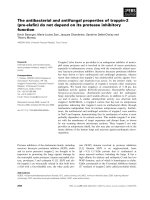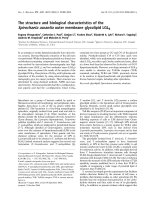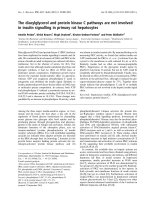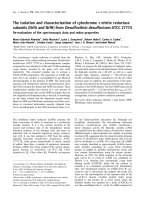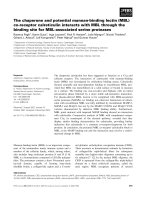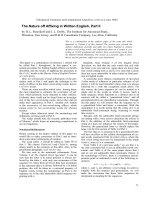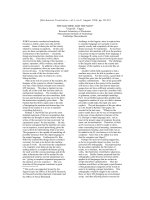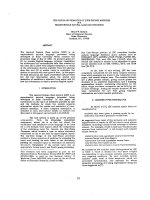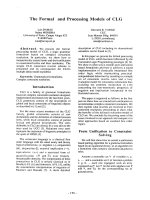Báo cáo khoa học: The enantioselectivities of the active and allosteric sites of mammalian ribonucleotide reductase pptx
Bạn đang xem bản rút gọn của tài liệu. Xem và tải ngay bản đầy đủ của tài liệu tại đây (183.64 KB, 7 trang )
The enantioselectivities of the active and allosteric sites
of mammalian ribonucleotide reductase
Jian He
1
,Be
´
atrice Roy
2
, Christian Pe
´
rigaud
2
, Ossama B. Kashlan
3
and Barry S. Cooperman
1
1 Department of Chemistry, University of Pennsylvania, PA, USA
2 Laboratoire de Chimie Organique Biomole
´
culaire de Synthe
`
se, Universite
´
Montpellier II, France
3 Department of Medicine, University of Pittsburgh, PA, USA
Ribonucleotide reductases (RRs, EC 1.17.4.1) form a
family of allosterically regulated enzymes that cata-
lyze the conversion of ribonucleotides to 2¢-deoxy-
ribonucleotides and are essential for de novo DNA
biosynthesis and repair, regulating other enzymes in
the DNA synthesis pathway via control of the nuc-
leotide pool [1]. Of the four known classes of RR
(Ia, Ib, II and III) class Ia, which requires two dif-
ferent subunits R1 and R2 for activity and catalyzes
the reduction of all four common NDPs, is the most
widespread, comprising all eukaryotic RRs as well as
some from eubacteria, bacteriophages and viruses.
The R1 subunit contains the active site as well as
allosteric sites. We have recently demonstrated that
there are three such sites in murine R1 (mR1) (the
specificity or s-site, the adenine or a-site, and the
hexamerization or h-site) [2,3], leading to a complex
pattern of regulation of enzymatic activity, the major
features of which are summarized in Scheme 1, as
follows: (a) ATP, dATP, dGTP, or dTTP binding to
the s-site drives formation of R1
2
; (b) ATP or dATP
binding to the a-site drives formation of R1
4
, which
exists in two conformations, R1
4a
and R1
4b
, with the
latter predominating at equilibrium; (c) ATP binding
to the rather low affinity (K
d
1–4 mm) h-site, which
occurs at physiologically significant concentrations,
drives formation of R1
6
– dATP does not bind to
this site at physiologically significant concentrations;
(d) the R2
2
complexes of R1
2
,R1
4a
, and R1
6
are
enzymatically active, whereas the R2
2
complex of
mR1
4b
has little, if any, activity; and (e) the sub-
strate specificity of RR is determined by the ligand
occupying the s-site: ATP and dATP stimulate the
reduction of CDP and UDP, dTTP stimulates the
Keywords
allosteric sites; enantioselectivity;
L-ADP;
L-ATP; mammalian ribonucleotide reductase
Correspondence
B. S. Cooperman, Department of Chemistry,
University of Pennsylvania, Philadelphia,
PA 19104–6323, USA
Fax: 215 8982037
Tel: 215 8986330
E-mail:
(Received 25 October 2004, revised 20
December 2004, accepted 7 January 2005)
doi:10.1111/j.1742-4658.2005.04557.x
Here we examine the enantioselectivity of the allosteric and substrate bind-
ing sites of murine ribonucleotide reductase (mRR). l-ADP binds to the
active site and l-ATP binds to both the s- and a-allosteric sites of mR1
with affinities that are only three- to 10-fold weaker than the values for the
corresponding d-enantiomers. These results demonstrate the potential of
l-nucleotides for interacting with and modulating the activity of mRR, a
cancer chemotherapeutic and antiviral target. On the other hand, we detect
no substrate activity for l-ADP and no inhibitory activity for N
3
-l-dUDP,
demonstrating the greater stereochemical stringency at the active site with
respect to catalytic activity.
Abbreviations
mRR, mammalian ribonucleotide reductase; mR1, large subunit of mammalian ribonucleotide reductase; mR2, small subunit of mammalian
ribonucleotide reductase; N
3
-D-dUDP, 2¢-azido-2¢-deoxy-b-D-uridine 5¢-diphosphate; N
3
-L-dUDP, 2¢-azido-2¢-deoxy-b-L-uridine 5¢-diphosphate;
RR, ribonucleotide reductase.
1236 FEBS Journal 272 (2005) 1236–1242 ª 2005 FEBS
reduction of GDP and dGTP stimulates the reduc-
tion of ADP. dATP is a universal inhibitor of RR
activity due to its induction of R1
4b
formation as a
result of a-site binding, whereas ATP is a universal
activator because it induces R1
6
formation as a
result of h-site binding.
RR is a well-recognized target for cancer chemo-
therapeutic and antiviral agents [4–7], as illustrated by
the anticancer drugs hydroxyurea [8] and gemcitabine
[9,10]. In recent years, l-nucleoside analogues have
been examined as novel therapeutic agents, which have
been shown to sometimes have comparable or higher
antiviral activity than their d-counterparts, as well as
more favorable toxicological profiles and superior
metabolic stability [11–15]. Studies at the individual
enzyme level have shown that l-nucleosides and
l-nucleotides can bind to human or other mammalian
enzyme active sites (reviewed in [16,17]) and sometimes
act as substrates, in particular as phosphate donors
and acceptors, as is the case for l -ATP and deoxycyti-
dine kinase [18,19], l-nucleosides and deoxycytidine
kinase, thymidine kinase 2 and deoxyguanosine kinase
[20], l-nucleoside-5¢-monophosphates and UMP-CMP
kinase [21], and, most recently l-nucleoside-5¢-diphos-
phates and phosphoglycerate kinase [22,23]. In
contrast, almost no investigations of interactions of
l-nucleosides or l-nucleotides with allosteric sites have
been reported (although see [13]). In the present work,
we examine the abilities of l-ATP and of l-ADP
(Fig. 1) to interact with the allosteric sites and active
site of mR1, respectively. We also demonstrate that
mRR displays enantiospecificity with respect to the
b-d-configuration of the sugar moiety of 2¢-azido-2¢-
deoxyuridine-5¢-diphosphate, paralleling our recent
results with Escherichia coli RR [24].
Results and Discussion
L-ATP is an allosteric effector of CDP reductase
CDP is the only one of the four ribonucleoside diphos-
phate substrates that is reduced by mRR with a signi-
ficant activity in the absence of allosteric effectors,
albeit with a high K
m
and a low k
cat
. Addition of
3mmd-ATP both lowers K
m
and raises k
cat
[2]. In the
absence of d-ATP, CDP reductase activity shows a
biphasic response to l-ATP, first increasing and then
decreasing (Fig. 2). Both the maximal observed activity
and the concentration of l-ATP giving maximum
activity vary with [CDP], with the first increasing and
the second decreasing as [CDP] is increased. In the
presence of d-ATP, however, CDP reductase shows
only a monotonic decline as a function of [l-ATP],
with the apparent IC
50
increasing only slightly as
[d-ATP] is increased (Fig. 3).
The effects of l -ATP on CDP reductase activity clo-
sely mirror those obtained with dATP, albeit at much
higher concentrations [2], and are well rationalized by
Scheme 1. The results in Fig. 2 provide evidence that,
like dATP, l-ATP binds first to the s-site, inducing
active R1
2
formation, and then to the a-site, inducing
inactive R1
4b
formation, thus accounting for the
biphasic curves observed. The changes in the curves in
Fig. 2 as a function of CDP concentration are consis-
tent with the known induction of R1
2
formation by
high levels of CDP, with the result that achieving max-
imal activity requires lower [l-ATP]. In contrast, we
have previously shown that CDP reductase activity has
a triphasic response to increasing d-ATP concentra-
tion, first increasing, then decreasing, then increasing
again as d-ATP binds to the s-, a- and h-sites in
sequence [2]. High concentrations of l-ATP do not
lead to a third phase activation of CDP reductase,
leading to the conclusion that l-ATP, like dATP,
L-ATP
dATP
ATP
dGTP
dTTP
L-ATP
dATP
ATP
Scheme 1. Allosteric ligand effects on enzyme aggregation state
and activity [2,3]. R2 has been omitted for simplicity – activity
assays were carried out in the presence of saturating [R2]. States
shown with white text on dark background have high activity; those
on white background have little or no activity. Inclusion of
L-ATP is
based on results reported herein.
Fig. 1. The structures of D- and L-adenine nucleotides.
J. He et al. Enantioselectivity of ribonucleotide reductase
FEBS Journal 272 (2005) 1236–1242 ª 2005 FEBS 1237
does not bind to the h-site, at least at concentrations
10 mm.
With CDP as substrate, the dissociation constants of
l-ATP for the s- and a-sites, calculated as described
[2], are approximately 200 lm and 1000 lm, respect-
ively. These values are three- to 10-fold higher than
the corresponding values for d-ATP (25 lm and
300 lm, respectively [2]), demonstrating the only
modest enantioselectivity at these two sites. The
three-dimensional structure of mR1 has not yet been
determined. However, its s-site and a-site are likely to
be very similar to those determined for the E. coli class
Ia R1 (eR1 [25]), as almost all of the contact residues
in each of these sites in eR1 are conserved in mR1
(the s-site interactions are also largely conserved in
known class Ib and class II structures [26–28]). It thus
seems likely that the only modest loss in l-enantiomer
affinity at these two sites reflects conservation of the
known triphosphate and base interactions, with
decreased affinity mainly resulting from loss of the
interactions with the ribose, e.g. in the s-site, between a
specific Asp (D232 in eR1, D226 in mR1) and the
ribose 3¢-OH.
In the presence of 0.2 mmd-ATP (Fig. 3a), mR1
should largely partition between active mR1
2
, with
d-ATP bound to the s-site only, and inactive mR1
4b
,
with d-ATP bound to the s- and a-sites [2]. Addition
of l-ATP should lead to saturation of the a-site and
complete conversion to mR1
4b
, leading to the observed
monophasic inhibition. By contrast, at higher d-ATP
(3 mm, Fig. 3c), d-ATP should be bound to all three
sites, s-, a-, and h-, and mR1 should be mostly in
the form of active mR1
6
[2]. Earlier we showed that,
under similar conditions, addition of dATP led to
inhibition of activity, largely as a result of dATP
displacement of d-ATP from the a-site, which weakens
the binding of mR2
2
to mR1
6
[3]. It is likely that
the l-ATP inhibition seen in Fig. 3c has a similar
explanation.
L-NDP interaction with the mR1 substrate site
An HPLC assay was used to determine whether
l-ADP could mimic d-ADP in being reduced by mRR
in the presence of the allosteric effector dGTP bound
to the s-site [2]. As seen in Fig. 4, approximately 11%
of d-ADP is converted to d-dADP when d-ADP is
incubated for 2 h in the presence of mRR and dGTP.
Fig. 2. The effect of L-ATP on CDP reductase in the absence of
D-ATP. Assays were carried out by preincubating 1.2 lM R1, 2.0 lM
R2, and varying concentrations of L-ATP for 7 min prior to
[8–
3
H]CDP addition.
Fig. 3. The effect of L-ATP on CDP reductase in the presence of
D-ATP. Activities were carried out as in Fig. 2, but with a fixed
amount
D-ATP in the preincubation buffer.
Fig. 4. L-ADP is not a substrate for RR. Samples were incubated
for 2 h at 25 °C in buffer A containing dGTP (300 l
M), R1
(0.84 l
M), R2 (4 lM) and either (a) D-ADP (400 lM) or (b) L-ADP
(400 l
M). Quenched reaction mixtures were analyzed by HPLC.
Retention times: dGTP 25 ± 2 min (
L or D)-ADP 24 ± 1 min, D-dADP
30 ± 1 min. The peaks at 29 ± 1 min and 33 ± 1 min are from
D-dAMP and oxidized dithiothreitol, respectively.
Enantioselectivity of ribonucleotide reductase J. He et al.
1238 FEBS Journal 272 (2005) 1236–1242 ª 2005 FEBS
By contrast, no conversion of l-ADP to l-dADP is
detectable under comparable conditions, or even
employing 14 times as much enzyme for periods up to
8 h (Fig. 4B). These results lead to the conclusion that
the specific activity of mRR for reduction of l-ADP is
< 1% of that for d-ADP. Similarly, under conditions
in which preincubation with the known suicide inhib-
itor N
3
-d-dUDP [29] at a concentration of 20 lm redu-
ces CDP reductase activity by 80%, incubation with
up to 250 lm N
3
-l-dUDP leads to no reduction in
activity (Fig. 5). These results parallel those we
obtained with E. coli RR [24].
Although the results in Figs 4 and 5 demonstrate the
failure of l-NDPs to act as a substrate or as a mechan-
ism-based inhibitor, l-ADP can clearly bind to the
substrate site, as shown by its inhibition of d-ADP
reduction (Fig. 6). Measured in the presence of 2 mm
d-ATP, which is sufficient to saturate the a-site and
most of the h-site, l-ADP is a classic competitive
inhibitor of dGTP-dependent d-ADP reductase, with a
K
i
of 1.0 mm, about 11-fold higher than the apparent
K
m
for d-ADP of 91 lm (Fig. 6A,B). As above, this
probably reflects retention of the base and especially
b-phosphate interactions at the active site and loss of
the specific ribose interactions that are crucial for sub-
strate activation [25]. l-ADP also displays competitive
inhibition in the absence of d-ATP (Fig. 6C), but the
nonlinearity of the secondary plot (Fig. 6D) is an indica-
tion of interaction at more than just the substrate site.
One possibility is that, in the absence of d-ATP, l-ADP
not only acts as a competitive inhibitor, but also binds
to the otherwise empty a-site at high concentrations,
permitting it to act as an allosteric inhibitor as well.
Here we note that high concentrations of d-ADP induce
mR1
4
formation [2], providing evidence for NDP bind-
ing to the a-site.
L-Nucleosides as potential therapeutic agents
directed against ribonucleotide reductase
We detect no substrate activity for l-ADP and no irre-
versible inhibitory activity for N
3
-l-dUDP, demonstra-
ting the considerable stringency at the active site of
mR1 with respect to catalytic activity. On the other
hand, our results show that l-ADP binds to the active
site and l-ATP binds to both the s- and a- allosteric
sites of mR1 with affinities that are only three- to
10-fold weaker than the values for the corresponding
d-enantiomers, demonstrating the potential of l-nucleo-
tides for interacting with and modulating the activity
of RR. Particularly intriguing in this regard is the
allosteric ligand dATP, which inhibits RR through a
very high affinity interaction with the a-site (K
d
, 0.3–
1 lm [2]). Efforts to explore the interaction with RR
of l-enantiomers of dATP and dATP analogues are
currently underway.
Experimental procedures
Materials
N
3
-d-dUDP and N
3
-l-dUDP were synthesized as described
[24]. l-AMP was obtained in 74% yield by selective phos-
phorylation of l-adenosine with POCl
3
in triethylphosphate
[30]. After being converted to its tri-n-butylammonium salt,
l-AMP was first reacted with 1,1¢-carbonyldiimidazole
in 1,3-dimethyl-3,4,5,6-tetrahydropyrimidin-2(1H)-one and
then with tri-n-butylammonium phosphate to give l-ADP
in 15% yield [31]. l-ATP was obtained in 41% yield
according to the Ludwig procedure [32]. l-ADP and l-ATP
were purified to homogeneity, as judged by HPLC and
HRMS, by DEAE-Sephadex A-25 and RP18 chromatogra-
phy, and converted to the respective sodium salts by
passage through a Dowex-AG 50WX2-400 column. The
l-nucleotides were fully characterized by NMR (
1
H,
13
C,
31
P), fast-atom-bombardment MS, UV spectroscopy and
polarimetry. l-ADP: [a]
20
D
+29 (c 1.0, H
2
O);
31
P NMR
(D
2
O, 300 MHz) d )8.2 (d, J
P–P
¼ 20.6), )10.8 (d, J
P–P
¼
20.6); MS FAB
+
m ⁄ z 472 (M + H)
+
; HRMS
(C
10
H
14
O
10
N
5
P
2
Na
2
), calculated 472.0011, found 471.9999.
l-ATP: [a]
20
D
+22 (c 1.0, H
2
O);
31
P NMR (D
2
O, 300 MHz)
d )6.2 (d, J
P–P
¼ 18.2), )10.7 (d, J
P–P
¼ 18.2), )20.5
(t, J
P–P
¼ 18.2); MS FAB
+
m ⁄ z 574 (M + H)
+
; HRMS
(C
10
H
14
O
13
N
5
P
3
Na
3
), calculated 573.9494, found 573.9453.
Cloned murine R1 and R2 were prepared as described [33].
Protein concentration was estimated by Bradford assay [34]
Fig. 5. L-N
3
-UDP does not inactivate RR. Solutions of 4 lM R1,
8 l
M R2, and 2 mMD-ATP were preincubated in buffer A with the
indicated the amounts of N
3
-L-dUDP or N
3
-D-dUDP for 15 min (total
volume, 10 lL). Ninety microliters of [8-
3
H]CDP (278 lM)andD-ATP
(2 m
M) in buffer B were then added, and reaction was allowed to
proceed for 30 min before quenching. Reaction mixture analysis
was by phenyl boronate chromatography.
J. He et al. Enantioselectivity of ribonucleotide reductase
FEBS Journal 272 (2005) 1236–1242 ª 2005 FEBS 1239
using bovine serum albumin as standard. [2,8-
3
H]ADP was
purchased from Perkin Elmer (Shelton, CT, USA), [8-
3
H]-
CDP, and [8-
3
H]-GDP was purchased from Amersham (Pis-
cataway, NJ, USA). Radioactive nucleotides were purified by
aminophenyl boronate agarose column chromatography
before use. All the other nucleotides are from Amersham or
Roche (Mannheim, Germany).
Ribonucleotide reductase activity assay
RR was assayed by measuring the formation of [
3
H]dNDP
from [
3
H]NDP at 25 °C, as described [33]. Reactions were
carried out in buffer A (50 mm Hepes, pH ¼ 7.6, 10 mm
KCl, 10 mm MgCl
2
,25mm dithiothreitol, 7 mm NaF,
0.05 mm FeCl
3
)at25°C in a total volume of 100 lL, with
final protein concentrations (given as monomer) of mR1,
0.12–3.3 lm, and of mR2, 1.0–11 lm and the indicated
amount of nucleotides. mRR was preincubated for 7 or
10 min prior to [
3
H]NDP addition. Samples were quenched
(boiling water) after 10–40 min and analyzed by phenyl-
boronate-agarose chromatography. Under these conditions,
the amount of product formation was proportional to reac-
tion time.
HPLC analysis of RR-catalyzed reduction
Following quenching, reaction mixtures were centrifuged
through a Millipore Microcon YM-10 centrifugal filter to
remove proteins and filtrates were loaded onto a Higgins
C
18
RP-HPLC analytical column. The gradient was 0–2%
(v ⁄ v) acetonitrile in 20 min followed by 2–5% (v ⁄ v) aceto-
nitrile in 20 min, containing 10 mm triethylammonium
bicarbonate pH 7.7.
Acknowledgements
This work was supported by NIH grant CA 58567
(BSC) and by the CNRS (BR). We thank Gilles Gos-
selin for technical advice regarding l-nucleotide syn-
thesis.
Fig. 6. L-ADP inhibition of dGTP-dependent ADP reductase. Assay mixtures contained 0.21 lM R1, 1 lM R2, 100 lM dGTP, ± 2 mMD-ATP,
variable amounts of [8-
3
H]D-ADP and the indicated amounts of L-ADP. Preincubation time was 10 min prior to substrate addition. Reaction
was allowed to proceed for 40 min before quenching and analysis by phenyl boronate chromatography. (A) Lineweaver–Burke plot of
L-ADP
inhibition of dGTP-dependent
D-ADP reductase in the presence of 2 mMD-ATP. (B) Secondary plot of the slope values of A. (C) Lineweaver-
Burk plot of
L-ADP inhibition of dGTP-dependent D-ADP reductase in the absence of D-ATP. (D) Secondary plot of the slope values of (C).
Enantioselectivity of ribonucleotide reductase J. He et al.
1240 FEBS Journal 272 (2005) 1236–1242 ª 2005 FEBS
References
1 Eklund H, Uhlin U, Fa
¨
rnegordh M, Logan DT & Nor-
dlund P (2001) Structure and function of the radical
enzyme ribonucleotide reductase. Prog Biophys Mol Biol
77, 177–268.
2 Kashlan OB, Scott CP, Lear JD & Cooperman BS
(2002) A comprehensive model for the allosteric regula-
tion of mammalian ribonucleotide reductase: functional
consequences of ATP- and dATP-induced oligomeriza-
tion of the large subunit. Biochemistry 41, 462–474.
3 Kashlan OB & Cooperman BS (2003) Comprehensive
model for allosteric regulation of mammalian ribonu-
cleotide reductase: refinements and consequences. Bio-
chemistry 42, 1696–1706.
4 Weber G (1983) Biochemical strategy of cancer cells
and the design of chemotherapy: G. H. A. Clowes
Memorial Lecture. Cancer Res 43, 3466–3492.
5 Cory JG (1988) Ribonucleotide reductase as a chemo-
therapeutic target. Adv Enzyme Regul 27, 437–455.
6 Szekeres T, Fritzer-Szekeres M & Elford HL (1997) The
enzyme ribonucleotide reductase: target for antitumor
and anti-HIV therapy. Crit Rev Clin Lab Sci 34,
503–528.
7 Robins MJ (1999) Mechanism-based inhibition of ribo-
nucleotide reductases: new mechanistic considerations
and promising biological applications. Nucleosides
Nucleotides 18, 779–793.
8 Stevens MR (1999) Hydroxyurea: an overview. J Biol
Regul Homeost Agents 13, 172–175.
9 Heinemann V (2003) Role of gemcitabine in the treat-
ment of advanced and metastatic breast cancer. Oncol-
ogy 64, 191–206.
10 Tsimberidou AM, Alvarado Y & Giles FJ (2002) Evol-
ving role of ribonucleotide reductase inhibitors in hema-
tologic malignancies. Expert Rev Anticancer Ther 2,
437–448.
11 Sommadossi JP (2002) Antiviral b-l -nucleosides specific
for hepatitis B and virus infection. In Recent Advances
in Nucleosides: Chemistry and Chemotherapy (Chu CK,
ed), pp. 417–432. Elsevier, Amsterdam, the Netherlands.
12 Gumina G, Song GY, Chu CK (2001) l-Nucleosides as
chemotherapeutic agents. FEMS Microbiol Lett 202,
9–15.
13 Zemlicka J (2000) Enantioselectivity of the antiviral
effects of nucleoside analogues. Pharmacol Ther 85,
251–266.
14 Wang P, Hong JH, Cooperwood JS & Chu CK (1998)
Recent advances in l-nucleosides: chemistry and biol-
ogy. Antiviral Res 40, 19–44.
15 Cheng YC (2001) Potential use of antiviral l(–) nucleo-
side analogues for the prevention or treatment of viral
associated cancers. Cancer Lett 162, S33–S37.
16 Focher F, Spadari S & Maga G (2003) Antivirals at the
mirror: the lack of stereospecificity of some viral and
human enzymes offers novel opportunities in antiviral
drug development. Curr Drug Targets Infect Disord 3,
41–53.
17 Maury G (2000) The enantioselectivity of enzymes
involved in current antiviral therapy using nucleoside
analogues: a new strategy? Antiviral Chem Chemother
11, 165–190.
18 Tomikawa A, Kohgo S, Ikezawa H, Iwanami N, Shudo
K, Kawaguchi T, Saneyoshi M, Yamaguchi T (1997)
Chiral discrimination of 2¢-deoxy-l-cytidine, l-nucleo-
tides by mouse deoxycytidine kinase: low stereospecifici-
ties for substrates and effectors. Biochem Biophys Res
Commun 239, 329–333.
19 Verri A, Montecucco A, Gosselin G, Boudou V, Imbach
JL, Spadari S, Focher F (1999) ATP is recognized by
some cellular and viral enzymes: does chance drive enzy-
mic enantioselectivity? Biochem J 337, 585–590.
20 Wang J, Choudhury D, Chattopadhyaya J & Eriksson
S (1999) Stereoisomeric selectivity of human deoxyribo-
nucleoside kinases. Biochemistry 38, 16993–16999.
21 Liou JY, Dutschman GE, Lam W, Jiang Z & Cheng
YC (2002) Characterization of human UMP ⁄ CMP
kinase and its phosphorylation of d- and l-form de-
oxycytidine analogue monophosphates. Cancer Res 62,
1624–1631.
22 Krishnan P, Fu Q, Lam W, Liou JY, Dutschman G &
Cheng YC (2002) Phosphorylation of pyrimidine
deoxynucleoside analog diphosphates: selective
phosphorylation of 1-nucleoside analog diphosphates
by 3-phosphoglycerate kinase. J Biol Chem 277, 5453–
5459.
23 Gallois-Montbrun S, Faraj A, Seclaman E, Sommadossi
J-P, Deville-Bonne D & Ve
´
ron M (2004) Broad specificity
of human phosphoglycerate kinase for antiviral nucleo-
side analogs. Biochem Pharmacol 68, 1749–1756.
24 Roy B, Verri A, Lossani A, Spadari S, Focher F, Aub-
ertin A-M, Gosselin G, Mathe
´
C&Pe
´
rigaud C (2004)
Enantioselectivity of ribonucleotide reductase: a first
study using stereoisomers of pyrimidine 2¢-azido-
2¢-deoxynucleosides. Biochem Pharmacol 68, 711–718.
25 Eriksson M, Uhlin U, Ramaswamy S, Ekberg M, Regn-
strom K, Sjoberg BM & Eklund H (1997) Binding of
allosteric effectors to ribonucleotide reductase protein
R1: reduction of active-site cysteines promotes substrate
binding. Structure 5, 1077–1092.
26 Sintchak MD, Arjara G, Kellogg BA, Stubbe J & Dren-
nan CL (2002) The crystal structure of class II ribo-
nucleotide reductase reveals how an allosterically
regulated monomer mimics a dimer. Nat Struct Biol 9,
293–300.
27 Uppsten M, Fa
¨
rnegordh M, Jordan A, Eliasson R,
Eklund H & Uhlin U (2003) Structure of the large sub-
unit of class Ib ribonucleotide reductase from Salmo-
nella typhimurium and its complexes with allosteric
effectors. J Mol Biol 330, 87–97.
J. He et al. Enantioselectivity of ribonucleotide reductase
FEBS Journal 272 (2005) 1236–1242 ª 2005 FEBS 1241
28 Larsson KM, Jordan A, Eliasson R, Reichard P,
Logan DT & Nordlund P (2004) Structural mechan-
ism of allosteric substrate specificity regulation in a
ribonucleotide reductase. Nat Struct Mol Biol 11,
1142–1149.
29 Thelander L & Larsson B (1976) Active site of ribonu-
cleoside diphosphate reductase from Escherichia coli:
inactivation of the enzyme by 2¢-substituted ribonucleo-
side diphosphates. J Biol Chem 251, 1398–1405.
30 Yoshikawa M, Kato T & Takenishi T (1967) A novel
method for phosphorylation of nucleosides to 5¢-nucleo-
tides. Tet Lett 50, 5065–5068.
31 Hampton A, Kappler F, Maeda M & Patel AD
(1978) Use of adenine nucleotide derivatives to assess
the potential of exo-active-site-directed reagents as
species- or isozyme-specific enzyme inactivators. 2.
Isozyme-specific inactivation of a mammalian enzyme
and its significance in the possible design of fetal iso-
zyme targeted antineoplastic agents. J Med Chem 21,
1137–1140.
32 Ludwig J (1981) A new route to nucleoside 5¢-triphos-
phates. Acta Biochim Biophys Acad Sci Hung 16, 131–
133.
33 Scott CP, Kashlan OB, Lear JD & Cooperman BS
(2001) A quantitative model for allosteric control of
purine reduction by murine ribonucleotide reductase.
Biochemistry 40, 1651–1661.
34 Bradford MM (1976) A rapid and sensitive method for
the quantitation of microgram quantities of protein util-
izing the principle of protein-dye binding. Anal Biochem
72, 248–254.
Enantioselectivity of ribonucleotide reductase J. He et al.
1242 FEBS Journal 272 (2005) 1236–1242 ª 2005 FEBS
